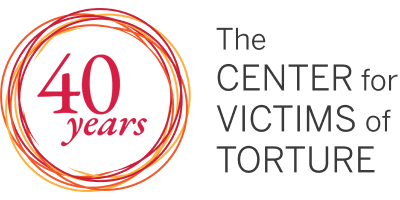Thirty years ago, Rita Manninen began her journey working with torture and war trauma survivors by volunteering at a refugee camp in Thailand. After this experience, Rita came back to the United States to pursue a Master in Public Health degree. It was during this time that she was introduced to the Center for Victims of Torture. In the process of acquiring her degree, she had the opportunity to interview a nurse working for CVT. This interview left an impression of CVT’s work with her, so when a health issue impacted her nursing career, she decided to support the organization by volunteering.
In 2003, Rita began volunteering at CVT in various positions – as a befriender, English tutor and bus tutor. She is currently one of CVT’s volunteer client services coordinators. This position requires identifying what’s necessary to help survivors and who can best assist them. Rita pairs survivors with volunteers to help them develop more individual skills and social interaction.
As a volunteer coordinator, Rita communicates with survivors, social workers and volunteers to address any concerns. Typically, volunteers communicate with her about the survivor’s progress. She then reiterates this information to social workers so they can properly support the survivor’s needs. She is responsible for appropriately pairing survivors with volunteers with whom they feel comfortable spending time. Sometimes meeting all of the survivor’s needs can be difficult because of the need to match personalities and schedules. Rita mentions how pairing volunteers to survivors of the opposite gender is rare. However, when it comes to short term services like tutoring, some survivors are comfortable working with volunteers of the opposite gender to help guide them.
There are also situations when a survivor’s location might limit volunteers. Traveling across town may be challenging for some volunteers. Language barriers are another challenging situation. Often times, this means creating alternative solutions for both volunteers and survivors. Regardless of the situation, Rita prioritizes respecting both the survivor’s and volunteer’s comfort level.
Rita emphasizes the amount of respect, privacy and sensitivity that is given to survivors’ personal lives. “When I say I work at the Center for Victims of Torture, the reaction is always, ‘Oh that must be very hard.’ But you know I don’t hear the torture stories very much or at all.” Volunteers help survivors piece together their futures, not their pasts. Her position has allowed her to meet many people with different stories and backgrounds. Her follow-up work with people has built a community with many.
Rita shares how amazing it is to see survivors’ growth and bright futures. Similarly, she is also able to observe the volunteers. “I see these survivors kind of bloom, and the volunteers are so rewarded by their work.” These reactions continue to benefit and strengthen the community for both survivors and volunteers.
